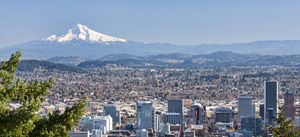
Portland, Oregon
Green Burial in Portland
Green burial can be the pie-in-the-sky part of the move to more natural, less-polluting disposition. Even if you convince them to bury you without a steel coffin or a wooden one made with toxic glues or toxic paints, or bearing plastic, made-to-look-like wood handles, few cemetery owners want to give up concrete vaults that outline and define plots. Not only do vaults keep the lawns level, they represent serious profits. So slipping on something biodegradable and slipping into Earth takes some doing and planning.
The good news is cemetery owners are responding to changing consumer demand. Increasingly, those who can set aside undeveloped acreage to use as natural burial ground do.
As the green movement takes root, it must be to the mirth of some religious groups -- such as Jews, Muslims and Russian Orthodox -- who have long sought to be buried simply, say, in shrouds and in contact with Earth. Although they would want to be buried grouped by religion, they must welcome an increasing willingness of cemetery owners to accommodate their customs. Some cemetery owners will resituate the burial liner to accommodate the body resting on Earth.
In Oregon, state law doesn't object to burial on private property. But the state doesn't recommend burial on your own property if only because, according to the state, the ground becomes sacred to purpose, and finding a buyer for an on-site cemetery could be difficult should you decide to sell.
Valley Memorial Park in Hillsboro is Oregon's only cemetery certified good-to-go green by the Green Burial Council, an outfit that has sought to codify ideas on what natural or green burial should be. The next closest Council-certified burial ground is White Eagle Preserve across the Columbia River and a little ways east of The Dalles. White Eagle opened in 2008.
The Green Burial Council basics dictate that green cemeteries do not allow embalming fluids, nonbiodegradable caskets or permanent grave liners or vaults. Green cemeteries use products that promote natural decomposition of a body.
That said, the Green Burial Council certifies three levels of burial grounds:
- Hybrid burial grounds combine conventional practices with green aspirations. In some instances, this mean vaultless burials. In other cases, land-use principles come into play.
- Natural burial grounds are green cemeteries that must engage in restoration planning and land stewardship. They need not hold conservation easements but must use deed restrictions or covenants that keep the land as green cemeteries.
- Conservation burial grounds are green cemeteries that partner with an established conservation group, build a conservation easements on the property, and operate on principles of restoration ecology.
